Julian Alaphilippe surges past Jelle Vanendert with Alejandro Valverde several metres behind, in the picture but for once out of contention. The Flèche has a new winner in Julian Alaphilippe although almost an old hand given he’s been on the podium here twice before. It was a good edition of a race that had become cycling’s equivalent of a repeat edition.
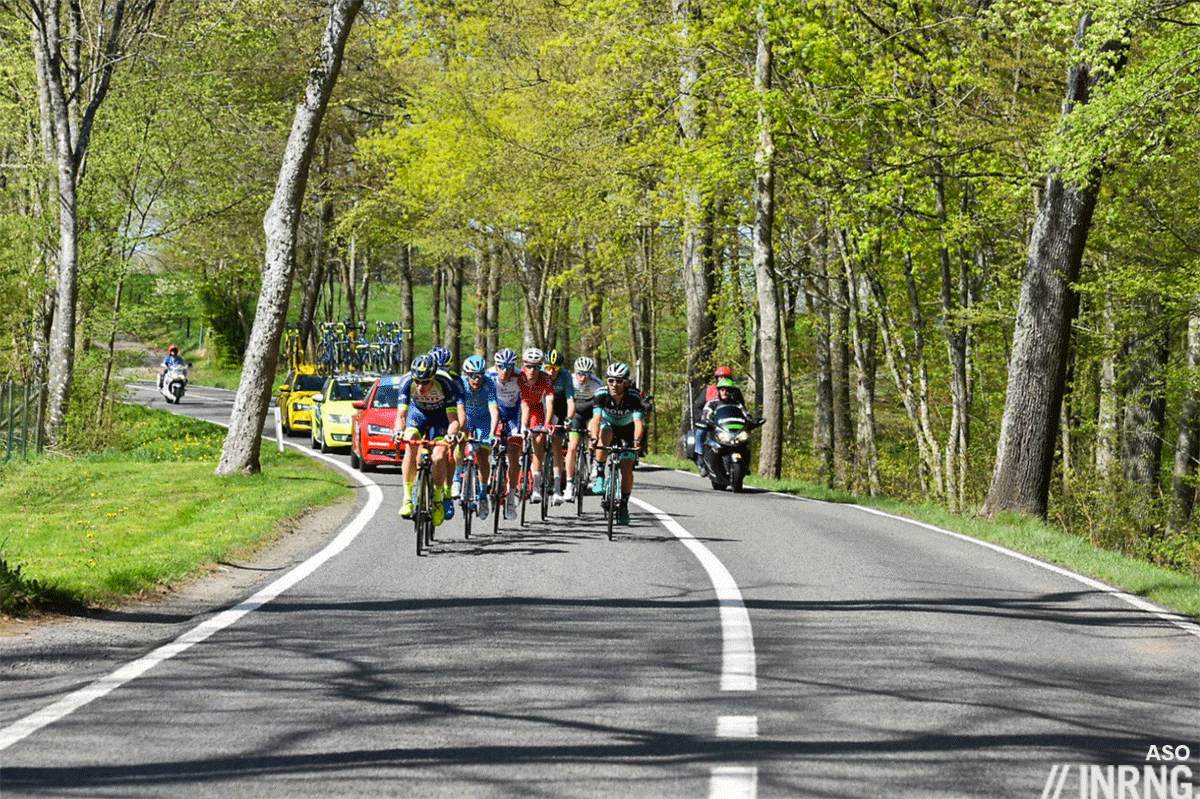
It was a warm day, spring had sprung with the woodland turning green. A group of eight riders went clear with two riders from the World Tour, Anthony Roux (Groupama-FDJ) and Cesare Benedetti (Bora-Hansgrohe) and their higher level would show when several hours later the move was caught by a counter move and only they could latch on.
Approaching the second time up the Mur de Huy several teams were firing riders up the road, presumably in a bid to sap Movistar. It was working and if finally the proverbial elastic snapped it seemed more to fray under the high speed racing rather than decisively break and Vincenzo Nibali, Jack Haig, Tanel Kangert and Max Schachmann got away and caught up with Roux and Benedetti. Nibali was enlivening another race but presumably on duty for the Izagirre brothers and Enrico Gasparotto, a golden lure while Haig looked strong and Kangert and Schachmann could both play the team card: they were policing the move and outsiders.
https://twitter.com/inrng/status/986602086535127040
Earlier this week Patrick Lefevere blasted race motorbikes for being too close to the racers and so their slipstreams were interfering with the race. Is he right? Yes it happens too often but let us note his intervention came just after the first time Quick Step hadn’t placed a rider on the podium in a spring classic. A handy diversion tactic? Again he’s right but he’s done this kind of polemic to get people to talk about something else than his team before. The riders were getting visibly angry with the TV moto at one point feeling it was helping the chase: Movistar’s eighth man of the day? Only at this point Movistar needed the help and Valverde had a loyal Mikel Landa working for him, helpful but hardly the tower of power he needed on the front of the bunch and it meant he was without anyone else to drop him into position.
Is the reduction in team sizes doing something to the racing, making it harder to control and the racing more lively? The long answer is that we can’t be sure, we cannot control for it by running two identical races, one with eight rider teams and the other with this year’s maximum of seven and then the same scenario over and over again until we can draw conclusions. The short answer is that just possibly it is.
200km and an uphill sprint. Yes for TV viewers but the peloton is stressed and the crashes kept coming. Lose a few places on a corner, a climb or a descent and it’s hard to move up. Do it several times and you’ve wasted enough energy to mean you arrive at the foot of the Mur de Huy with jelly legs. Tiesj Benoot was leading into the Côte de Cherave which suggested Lotto-Soudal hoped Tim Wellens or Jelle Vanendert could take on Valverde on the final climb, otherwise why else chase? There was a brief flurry of attacks and Alejandro Valverde went in person to close things down. A sign of strength or weakness? With hindsight this was energy he’d rather save.
Ahead the breakaway had fractured and it was down to Haig and Schachmann and the pair sped along the banks of the Meuse towards Huy with 30 seconds. As a rule a breakaway needs at least 45 seconds going into the final ascent of the Mur such is the ability of those in the bunch to surge up. Still Schachmann kept going and if he never had enough at the foot of the climb in Huy to win his presence forced Lotto-Soudal to chase. Jelle Vanendert led the charge up the hill, a mountain stage win in the 2011 Tour de France to his name but ever since he’s a regular in the Ardennes races but rarely beyond, and a support actor rather than the star. This looked like a different way of racing up, normally there’s a waiting game and some marking but this was much more of a straight, hard effort. Quick Step used Bob Jungels and then Philippe Gilbert as lead outs for Julian Alaphilippe, a royal train.
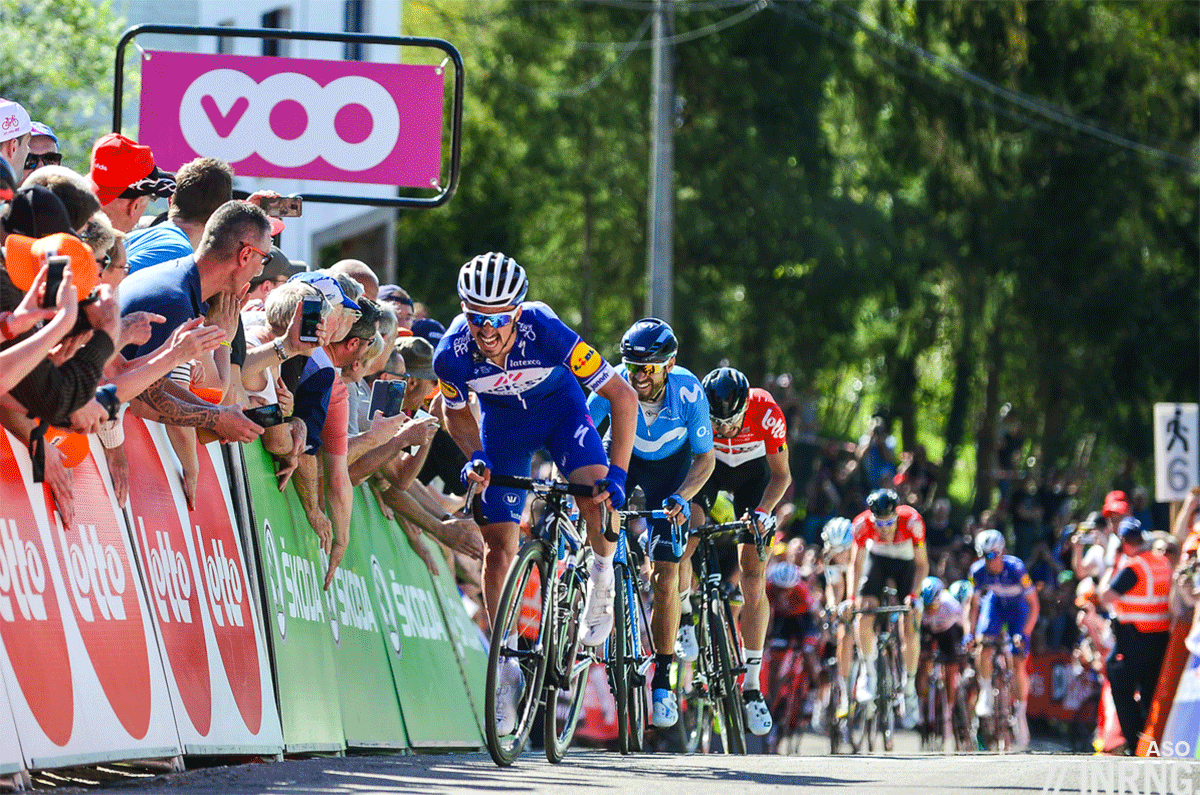
As they rounded the final tight bend Alaphilippe looked back, could he see Alejandro Valverde behind him? Hard to say because the Spaniard was several lengths back and late for his appointment with the finish line. Either way Valverde was out of the picture and Alaphilippe put in his final explosive kick to overhaul Vanendert and take the win.
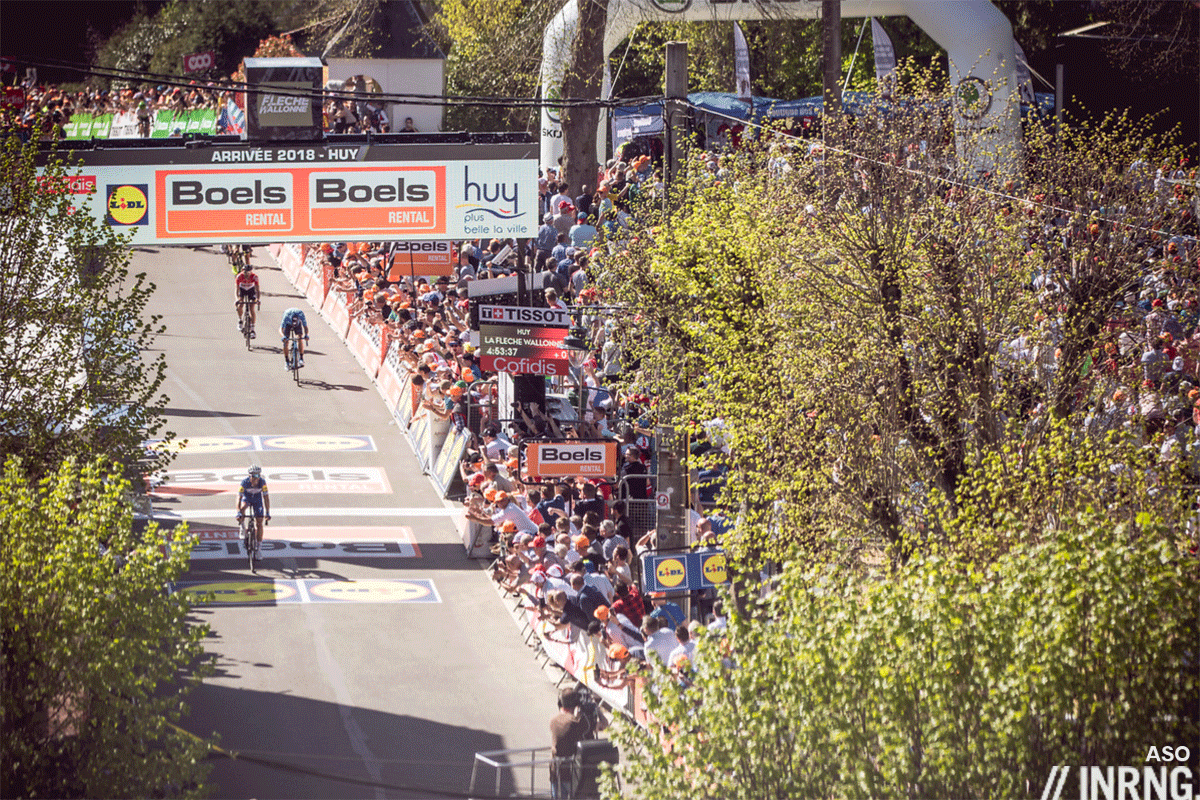
The Verdict
The best edition of the Flèche for some time because of the fine balance in the finish. No one team had control of the race and the late breakaway with the likes of Nibali, Haig and Schachmann had promise. Movistar ran out of riders leaving Valverde in person to cover the late moves and this might have cost them but for all that Valverde was defeated it was a matter of metres, he was still second and if he’d replayed the finish he might have been closer. In contrast Alaphilippe could sit tight and even better he had a royal leadout into the final climb but he wasn’t sure if he was sprinting for the win, saying it was hard to hear his race radio and he thought Nibali might still be up the road. Tiesj Benoot’s generous efforts late in the race looked to be too kind to Valverde but ensured the break was pulled back. Vanendert surged up the Mur and was only overhauled at the end, perhaps inevitably but a strong result for this curious specialist. It all bodes well for Liège-Bastogne-Liège this Sunday with the burden again on Quick Step and Valverde still very much in contention.
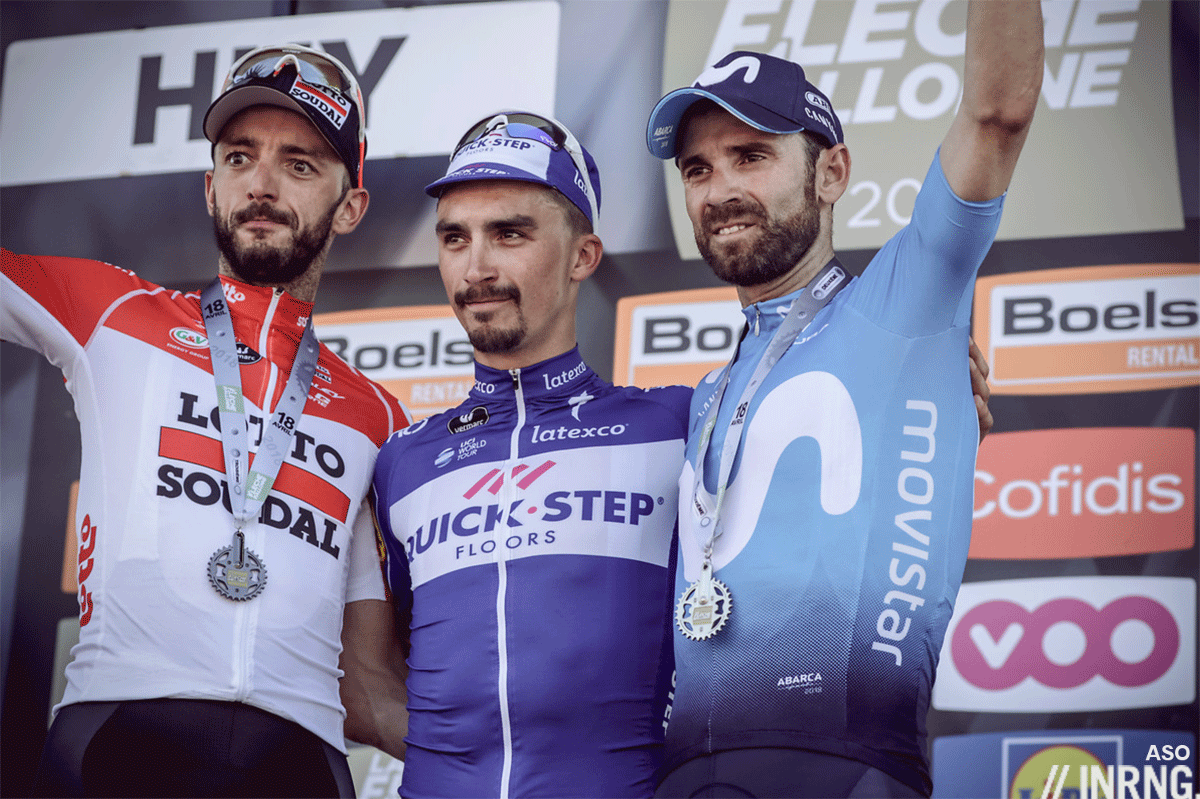

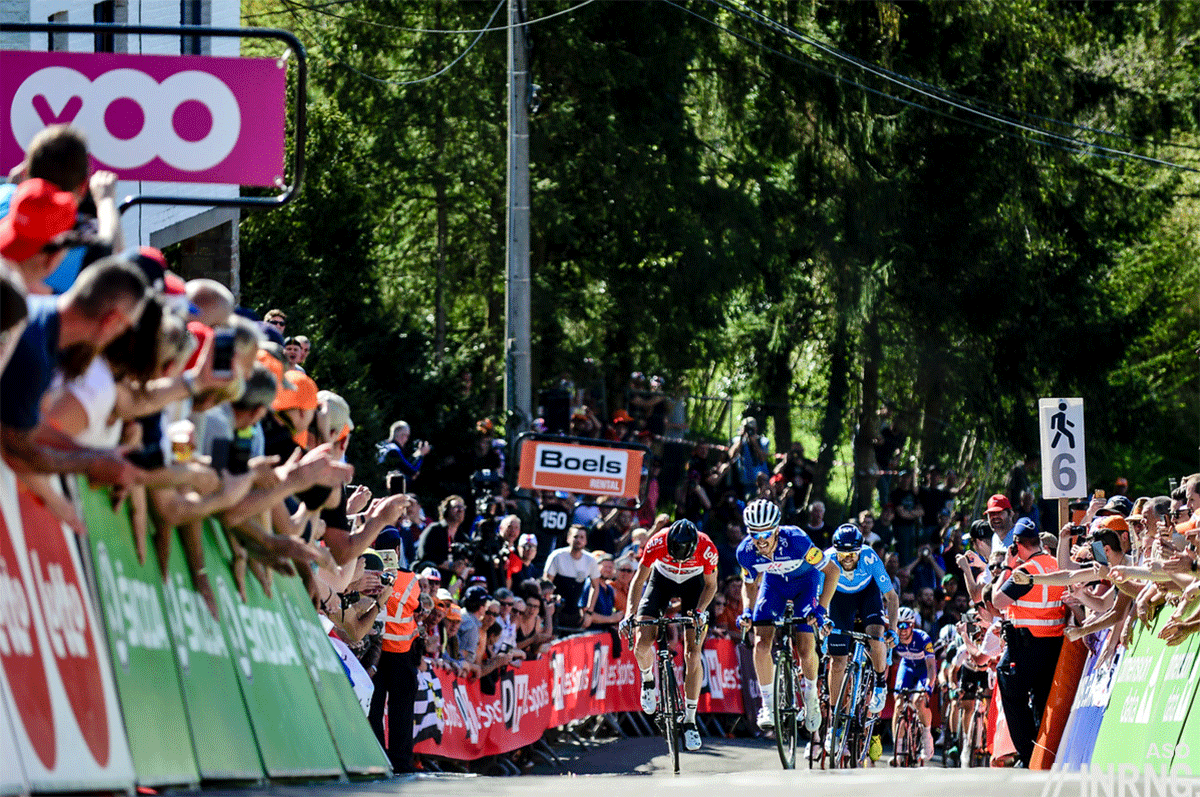
Wondering whether facial hair might have any effect on the result…
“The short answer is that just possibly it [does].” I won’t speculate on Alaphilippe’s smooth cheeks being more aerodynamic, though.
If it had been close on the finish line it would have been captioned “Alaphilippe won by a whisker”
+1
All three look a lot worse with their beards than without. That doesn’t apply for everyone, though.
Alaphillipe specifically, the others are fine.
I wonder if Valverde will show up at the start on Sunday sans beard. It seemed like it was bushier at AGR last week, and a little more trimmed on Wednesday. Maybe the length of his beard is inversely proportional to the seriousness with which he approaches the race. There’s got to be an adverse aerodynamic effect to riding with facial hair for 200+ kilometers, right?
Forget whiskers – I’d watch out for the riders with dimples – makes golf balls fly further/faster!
Regarding the issue of reduced team sizes, we can look at Inner Ring’s latest Team Victory Ranking article of 29/03/18.
This has the top two teams (Quick Step and Sky) sharing 34 x victories.
Movistar and Mitchelton Scott next have 11 x victories each, totalling 22.
Then come five teams all with 8 x victories each, 40 x added together.
Compare this with the Team Victory Rankings of 27/03/17 and the two top teams also had 34 x victories between them.
The next two teams shared 26 x victories, and the next five teams had 32 x victories.
So it could be possible to crudely say that smaller team sizes has so far spread the victories around a little more evenly.
Although the two strongest teams, Quick Step and Sky, have both continued to thrive and indeed each show a stronger return of total victories than this time last year.
There has also been some notable ‘anomalies,’ if for example you can call Valgren’s, Benoot’s and Nibali’s Spring victories as such, as they did fly somewhat against expectation, that may suggest that team tactics can be more difficult to control with a rider less.
I also recall a piece that you did (last year or perhaps even 2016?) on how the long successful breakaway was vanishing from the sport, but there’s been numerous notable examples of winning breakaways from distance since then and particularly this year. Whether that is down to teams having to be more creative is hard to say.
But, all told, it’s been a pleasing season to watch so far with some really interesting tactical battles to enjoy.
Long breaks are still rare, it’s possible to go late in a race, perhaps more so these days, but the 200km solo raids are rare although they always were. That piece on long breaks, in case anyone else wants to have a read, is at http://inrng.com/2016/07/raiders-of-the-lost-art/
Good summary again Inrng.
In my view as well an exciting edition of the event, and proof if it were needed that the riders make the race. Several teams efforts to isolate Valverde proved the correct strategy. Alaphilippe a very worthy winner after several near misses. Once again Nibali shows why he is such an exceptional, exciting and attacking rider across the road disciplines.
The race route changed again this year in addition to the reduction in team sizes. Riders don’t make a race out of thin air.
Anyone know why Nibali was dropped on that last descent? The feed on SBS was a one man band and McCrossin(?) was talking up Nibali’s descending which is usually something to behold. Haig was riding like a seasoned pro doing big turns but you knew it would come to nought. Glad someone else won the race for once.
Reportedly, a traffic divider where Mate had crashed the lap before was tackled aggresively by Haig, perhaps in order to split the break. On the one hand, that might look a good move by Haig, he probably felt that if the four made the wall he personally had no chances; but, OTOH, that split meant that the break lost way more than half of its horsepower, reducing to nope any remaining hope.
The question of motobike influence needs to be better regulated. The television spectator likes high quaility images but requires fair racing too. The two are not incompatible. Maybe the UCI could start by defining the power saving due to moto presence it is prepared to tolerate, say 20W. This would then lead to a definition of, for a number of given speed, road and wind conditions, the distance required to avoid saving >20W. What is certain is that very substantial power savings are being provided regularly by camera motos and that those savings are influencing races.
It’s a wonderful theory, but something i just don’t know how anyone can enforce. Given TV motos are hired and operated by the TV networks, who buy the rights from the race operator, who get lisencing from the UCI. So where do we put the power?
The UCI have clear regulations on motos and vehicles around the race, but they don’t run the races and it is the race organiser who is supposed to control and make sure those regulations are followed. Although they’ll probably pass on the documents to the TV network for them to give to the moto drivers. Everyone will say they are doing the right thing and that it’s someone elses fault.
And that’s not including how you accuratly define Watt influence, given different riders will make different Watt outputs on different gradients on different tyres on different bikes or different road surfaces in different winds. Simplify that to just a set distance though and there’s something… except that’s already supposed to be in place…
Exactly Hammarling – there is no theoretical perfect way to enforce this. There is a general understanding and potentially a rule for this, but really it just needs to be enforced by commissaires and competing riders if it happens. It’s why riders like Kwiat who have their heads in the race need to pay attention to what is happening.
Really impressive Vanendert riding the Mur from the front all the way up. Watch him take over the lead with 1 km to go just before the gradient kicks from mellow to +8% watch. https://www.youtube.com/watch?v=cTJhg0ulpIE. He said he went a 100% at the sharp bend but looking back should have saved some energy at this point. I think he was not aware that he was riding almost everyone incl. Wellens off his wheel. I guess team management must have been equally surprised by his individual performance on the day.
Nice port-race interview from Valverde. Very gracious in defeat
Valverde produced exact the same climbing time as in previous years, while it looked to us as if he lacked the usual punch. The impressive straight pace setting by Vanendert made the climb a different story for everybody, some endured it better than others.
Agreed. Valverde has always preferred to wait, wait, and wait on someone’s wheel before doing a rather long sprint to the line. Not only on the mur but in general.
It was interesting to see that Movistar and Valverde himself still don’t know how to properly play a game of poker. Who else if not them could afford to say: It’s your race to win, we have won this one so often and already so many other races this year, feel free to chase the escapers or not, we’ll just enjoy the show.
Puzzle of the day: On one of these fotos is an INRNG Cap. Where is it?
Beats me and I went to look at my hi-res originals, had a quick look and didn’t see one.
Its me in the middle foto where Alaphillipe leads the sprint. You can see the inrng cap left of Alaphillipe shoulder. Next to me stood the guy who directed the movie “Icarus” by the way
Nibali once again ennobled the race, as INRNG likes to say. He has ennobled this entire classics season.
It has crossed my mind that maybe he feels a Grand Tour is no longer within reach, so he is hunting for some top quality one-day wins to add to his palmares.
He was hunting for Classics before he was even able to seriously compete for a GT because of his young age (he’s got a Liège top-ten in 2008 and Plouay in 2006 was his 2nd pro win), and while he was actually in the GT big business he went on going for one-day races as well (in 2010 he got a top-5 at the Lombardia right after winning the Vuelta; in 2011 he podiumed at the Giro and got top-tens in Sanremo and Liège, then attacking solo 50 kms to the line at Lombardia; in 2012 he podiumed at the Tour, the Sanremo and the Liège).
What’s true is that in 2014 the TdF victory corresponded to his poorest season ever in terms of one-day racing, Nats aside (but IMHO the 4th at the Worlds the year before was more worthy); then, luckily enough, his Vuelta exclusion in 2015 helped him to “re-discover” the pleasures of one-day racing and grab those three Mouments… which didn’t prevent him from winning another Giro and get a couple of GT podia more, too.
I must say that I didn’t appreciate at all the way they set his calendar in 2014 and for the most part of 2015, but it’s less than two seasons in a dozen ones.
Maybe Nibali feels this type of training will help for the TdF this year… seeing that it might be wide open and the cobbled stage might decide the race again.
Mr. Inrng, please don’t do a Lance piece today…
A criticism of Landis would be a welcome change though.